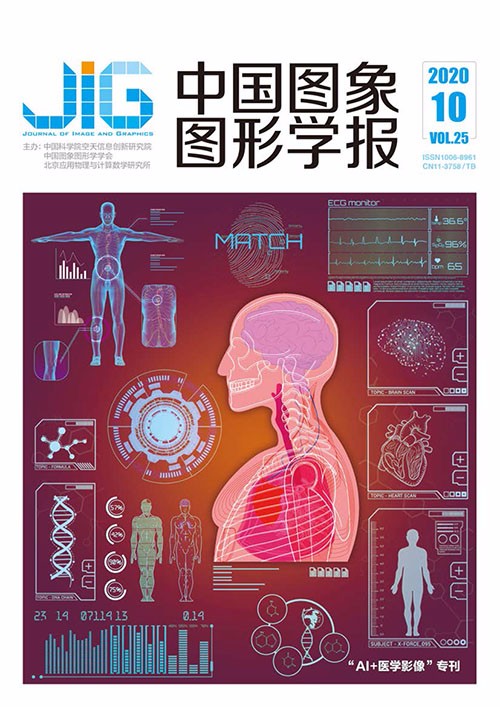
肝脏肿瘤CT图像深度学习分割方法综述
摘 要
肝脏肿瘤的精确分割是肝脏疾病诊断、手术计划和术后评估的重要步骤。计算机断层成像(computed tomography,CT)能够为肝脏肿瘤的诊断和治疗提供更为全面的信息,分担了医生繁重的阅片工作,更好地提高诊断的准确性。但是由于肝脏肿瘤的类型多样复杂,使得分割成为计算机辅助诊断的重难点问题。肝脏肿瘤CT图像的深度学习分割方法较传统的分割方法取得了明显的性能提升,并获得快速的发展。通过综述肝脏肿瘤图像分割领域的相关文献,本文介绍了肝脏肿瘤分割的常用数据库,总结了肝脏肿瘤CT图像的深度学习分割方法:全卷积网络(fully convolutional network,FCN)、U-Net网络和生成对抗网络(generative adversarial network,GAN)方法,重点给出了各类方法的基本思想、网络架构形式、改进方案以及优缺点等,并对这些方法在典型数据集上的性能表现进行了比较。最后,对肝脏肿瘤深度学习分割方法的未来研究趋势进行了展望。
关键词
Review of deep learning segmentation methods for CT images of liver tumors
Ma Jinlin, Deng Yuanyuan, Ma Ziping(College of Computer Science and Engineering, North Minzu University, Yinchuan 750021, China) Abstract
Hepatocellular carcinoma is one of the most common malignant tumors of the digestive system in clinic. It ranks third after gastric cancer and lung cancer in the death ranking of malignant tumors. Computed tomography (CT) can well display the organs composed of soft tissue and show the lesions in the abdominal image. It has become a typical method for the diagnosis and treatment of liver diseases. It produces high-quality liver imaging that can provide comprehensive information for the diagnosis and treatment of liver tumors, alleviate the heavy workload of doctors, and have an important value for subsequent diagnosis and treatment. Segmentation of CT images of liver tumors is a crucial step in the diagnosis of liver cancer. In accordance with the maximum diameter, volume, and number of liver lesions, medical workers can give patients accurate diagnosis results and treatment plans conveniently and rapidly. However, the manual three-dimensional segmentation of liver tumors is time consuming and requires substantial work. Therefore, a method for automatically segmenting liver tumors is urgently needed. Many challenges occur in the segmentation of liver tumors. First, the CT image of a liver tumor shows the cross section of the human body, and the contrast of the liver and liver tumor tissue is inconsiderably different from that of the surrounding adjacent tissues (such as the stomach, pancreas, and heart). The segmentation by using grayscale differences is difficult. Second, the individual differences of patients result in diverse sizes and shapes of liver tumors. Third, CT images are susceptible to various external factors, such as noise, partial volume effects, and magnetic field bias. The interference of the shift makes the image blurry. Dealing with the effects of these factors in a timely manner is a great challenge for medical imaging researchers. Accurate segmentation can ensure that clinicians can make wise surgical treatment plans. With the rise of big data and artificial intelligence in recent years, assisted diagnosis of liver cancer based on deep learning has gradually become a popular research topic. Its combination with medicine can realize and predict the condition and assist diagnosis, which has great clinical significance. Segmentation methods for liver tumor CT images based on deep learning have also attracted wide attention in the past few years. From relevant literature in the field of liver tumor image segmentation, this paper mainly summarizes several commonly used segmentation methods for current liver tumor CT images based on deep learning, aiming to provide convenience to related researchers. We comprehensively summarize and analyze the deep learning methods for liver tumor CT images from three aspects: datasets, evaluation indicators and algorithms. First, we introduce common databases of liver tumors and analyze and compare them in terms of year, resolution, number of cases, slice thickness, pixel size, and voxel size to compare the segmentation methods for emerging liver tumors objectively. Second, several important evaluation indicators, such as Dice, relative volume difference, and volumetric overlap error, are also briefly introduced, analyzed, and compared to evaluate the effectiveness of each algorithm in the accuracy of liver tumor segmentation. On the basis of the previous work, we divide the deep learning segmentation methods for CT images of liver tumors into three categories, namely, liver tumor segmentation methods based on fully convolutional network (FCN), U-Net, and generative adversarial network (GAN). The segmentation methods based on FCN can be further divided into two- and three-dimensional methods in accordance with the dimension of the convolution kernel. The segmentation methods based on U-Net are divided into three subcategories, which are methods based on single network, methods based on multinetwork, and methods combined with traditional methods. Similarly, the segmentation methods based on GAN are divided into three subcategories, which are based on network architecture improvements, generator-based improvements, and other methods. The basic ideas, network architecture forms, improvement schemes, advantages, and disadvantages of various methods are emphasized, and the performance of these methods on typical datasets is compared. Lastly, the advantages, disadvantages, and application scope of the three methods are summarized and compared. The future research trends of liver tumor deep learning segmentation methods are analyzed. 1) The use of three-dimensional neural networks and network deepening is a future research direction in this field. 2) The use of multimodal liver images for segmentation and the combination of multiple different deep neural networks to extract deep information of images for improving the accuracy of liver tumor segmentation are also main research directions in this field. 3) To overcome the problem of lack or unavailability of data, some researchers have shifted the supervised field to a semi-supervised or unsupervised field. For example, GAN is combined with other higher-performance networks. This situation can be further studied in the future. In summary, accurate segmentation of liver tumors is a necessary step in liver disease diagnosis, surgical planning, and postoperative evaluation. Deep learning is superior to traditional segmentation methods when segmenting liver tumors, and the obtained images have higher sensitivity and specificity. This study hopes that clinicians can intuitively and clearly observe the anatomical structure of normal and diseased tissues through the increasingly mature liver tumor segmentation technologies. It provides a scientific basis for clinical diagnosis, surgical procedures, and biomedical research. The research and development of medical image segmentation technologies play an important role in the reform of the medical field and have great research value and significance.
Keywords
computed tomography(CT) liver tumor deep learning medical image segmentation fully convolutional network(FCN) U-Net generative adversarial network(GAN)
|



 中国图象图形学报 │ 京ICP备05080539号-4 │ 本系统由
中国图象图形学报 │ 京ICP备05080539号-4 │ 本系统由